This is a small collection of pictures from the trip we made to Bulgaria on 2000.
(Click on the pictures to enlarge them. In the text, some links point to pictures and some to related websites)
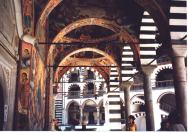
 We have some friends in Bulgaria (Ina and Marty) so we went there a couple of times and we spent a wonderful time. Though Bulgaria is a beautiful country to visit, I have no idea how a regular tourist could do it, as it is not very touristic friendly in general terms. We rented a car with our friends and followed them to a great variety of places, all of them fascinating. Sofia, the capital city, has no great things to offer, and all the fun is in the rest of the country. The first place to visit is very near from Sofia, an ancient monastery in the Rila (Рила) mountains. The monastery is very well preserved, and the frescoes are awesome. The contrast between the colourful paintings, the black and white archs and the green tall trees outside is breathtaking. It is one of the rare places in the world that is unique and incredible to see, but it is not ruined by tourists. There are a couple of them, to be honest: always a Japanese here and there with his camera taking pictures of everything, but not the flood of people you would usually find in the Sixtine Chapel, for example.
We have some friends in Bulgaria (Ina and Marty) so we went there a couple of times and we spent a wonderful time. Though Bulgaria is a beautiful country to visit, I have no idea how a regular tourist could do it, as it is not very touristic friendly in general terms. We rented a car with our friends and followed them to a great variety of places, all of them fascinating. Sofia, the capital city, has no great things to offer, and all the fun is in the rest of the country. The first place to visit is very near from Sofia, an ancient monastery in the Rila (Рила) mountains. The monastery is very well preserved, and the frescoes are awesome. The contrast between the colourful paintings, the black and white archs and the green tall trees outside is breathtaking. It is one of the rare places in the world that is unique and incredible to see, but it is not ruined by tourists. There are a couple of them, to be honest: always a Japanese here and there with his camera taking pictures of everything, but not the flood of people you would usually find in the Sixtine Chapel, for example.
 The surrounding mountains are an incredible context for this place, that was saved from the destruction of the Turks thanks to them. Most of the Bulgarian culture survived the five centuries oppression of the Turks hidden in monasteries, that is why they are so important. Another monastery we visited is the oldest Monastery in Bulgaria: Bachkovo (Бачковски манастир), that it is a bit closer to what the real life of a monastery looks like. They have priests and animals and it is not so touristic, so prepared to amaze like the one in Rila. People visit it because of its religious values, rather than for a touristic urge. The church itself is small and lovely, full of wood and looks very ancient. The priests are naturally very different from those we catholic risen people are used to. The Slavic world is normally forbidden for the common European tourist, and religion is one of the things that make the difference. You will not see here the rich catholic churches full of marble and gold: wood and frescoes are all the ornamentation, and it looks more reasonable this way. Luxury is not a thing that should belong to church. We got fed up of that in Rome, precisely in the Vatican. As a nonbeliever, I see all of this from the outside, naturally. The Slavic tradition and religious culture had a great deal of its beginnings with the Bulgarian brothers Cyril and Methodius, who invented the Cyrillic alphabet (and the Glagolitic as well), still used by many Slavic languages (up to fifty) like Ukrainian, Russian and of course Bulgarian.
The surrounding mountains are an incredible context for this place, that was saved from the destruction of the Turks thanks to them. Most of the Bulgarian culture survived the five centuries oppression of the Turks hidden in monasteries, that is why they are so important. Another monastery we visited is the oldest Monastery in Bulgaria: Bachkovo (Бачковски манастир), that it is a bit closer to what the real life of a monastery looks like. They have priests and animals and it is not so touristic, so prepared to amaze like the one in Rila. People visit it because of its religious values, rather than for a touristic urge. The church itself is small and lovely, full of wood and looks very ancient. The priests are naturally very different from those we catholic risen people are used to. The Slavic world is normally forbidden for the common European tourist, and religion is one of the things that make the difference. You will not see here the rich catholic churches full of marble and gold: wood and frescoes are all the ornamentation, and it looks more reasonable this way. Luxury is not a thing that should belong to church. We got fed up of that in Rome, precisely in the Vatican. As a nonbeliever, I see all of this from the outside, naturally. The Slavic tradition and religious culture had a great deal of its beginnings with the Bulgarian brothers Cyril and Methodius, who invented the Cyrillic alphabet (and the Glagolitic as well), still used by many Slavic languages (up to fifty) like Ukrainian, Russian and of course Bulgarian. 
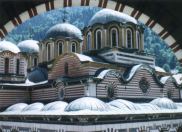 The best preserved churches and monasteries are in places difficult to get to. We even found a Russian church in a very unlikely place, the Shipka Temple (храм Шипка). In fact it’s not unlikely from the historical point of view: many Russians died during the liberation of Bulgaria, but you don’t expect a church there. Other monasteries we have been to are high (or carved into) in the mountains, like that of St. Kirik (Свети Кирик), Drianovo (Дряновски манастир) or Aladja in front of the Black Sea. The former was turned into a hotel, by the way. Another example of ancient buildings in the mountains is the Asen’s “fortress” (“Асенова Крепост”): after a long way up, we reached the fortress or what is left of it: a small church in the middle of an impressive landscape at the Rhodopean mountains.
The best preserved churches and monasteries are in places difficult to get to. We even found a Russian church in a very unlikely place, the Shipka Temple (храм Шипка). In fact it’s not unlikely from the historical point of view: many Russians died during the liberation of Bulgaria, but you don’t expect a church there. Other monasteries we have been to are high (or carved into) in the mountains, like that of St. Kirik (Свети Кирик), Drianovo (Дряновски манастир) or Aladja in front of the Black Sea. The former was turned into a hotel, by the way. Another example of ancient buildings in the mountains is the Asen’s “fortress” (“Асенова Крепост”): after a long way up, we reached the fortress or what is left of it: a small church in the middle of an impressive landscape at the Rhodopean mountains.
The Golden Age
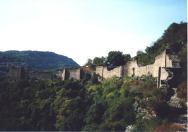 When we first saw it, we had no idea how we could get that high. The story of this place is related to the times when Bulgaria was a very important nation inside the European mosaic. Before the Russians, before the Turks, Bulgaria was a great country, and that greatness can be barely seen or guessed today in the ruins of the old castles. In our way to the Black sea we found many places where you could see the remains of that Golden age (Златен век), a time when the country was much bigger than it is now, back in the 9th century AD. I think the best place to visit and attest that is an old capital called Veliko Turnovo (Велико Търново), where a big castle is still preserved. The castle is huge, and the place where it was built is amazing, with an awesome view. There is the big entrance with a lion, and an ascending road to a church.
When we first saw it, we had no idea how we could get that high. The story of this place is related to the times when Bulgaria was a very important nation inside the European mosaic. Before the Russians, before the Turks, Bulgaria was a great country, and that greatness can be barely seen or guessed today in the ruins of the old castles. In our way to the Black sea we found many places where you could see the remains of that Golden age (Златен век), a time when the country was much bigger than it is now, back in the 9th century AD. I think the best place to visit and attest that is an old capital called Veliko Turnovo (Велико Търново), where a big castle is still preserved. The castle is huge, and the place where it was built is amazing, with an awesome view. There is the big entrance with a lion, and an ascending road to a church. 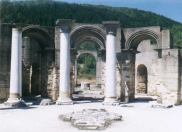 The castle was rebuilt and a great deal of how it looked like can be seen these days. The church itself has a strange detail: all the frescoes and art inside are modern things, something I have not seen in no church whatsoever. It was impressive. The style had something to do with Francis Bacon, so imagine how weird is to find that in a church. The city also is pretty nice to visit. Another old capital is Veliki Preslav (Велики Преслав).
The castle was rebuilt and a great deal of how it looked like can be seen these days. The church itself has a strange detail: all the frescoes and art inside are modern things, something I have not seen in no church whatsoever. It was impressive. The style had something to do with Francis Bacon, so imagine how weird is to find that in a church. The city also is pretty nice to visit. Another old capital is Veliki Preslav (Велики Преслав). 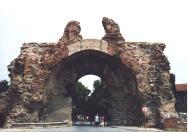 It is not that well preserved as Turnovo: some columns and walls are all that is left from destruction and time, but still is impressive (there is a beautiful selection of pictures from the ruins here). Near there, an awesome archeological museum surprised us, in the middle of nothing. To reach Preslav itself was not easy, and I imagine almost impossible for a foreigner. But just because of that, nobody is visiting the ruins, and they are all for yourself. You can walk here and there, and the silence transports you to that time when Preslav was full of people, medieval times. That is one of the most beautiful things about Bulgaria: I felt more than once as if it was just me and the past: you are alone with ancient places and buildings, you have the chance to actually let yourself go with your thoughts. A similar sensation I had in Hissar (Хисаря), where once there was a large Roman city.
It is not that well preserved as Turnovo: some columns and walls are all that is left from destruction and time, but still is impressive (there is a beautiful selection of pictures from the ruins here). Near there, an awesome archeological museum surprised us, in the middle of nothing. To reach Preslav itself was not easy, and I imagine almost impossible for a foreigner. But just because of that, nobody is visiting the ruins, and they are all for yourself. You can walk here and there, and the silence transports you to that time when Preslav was full of people, medieval times. That is one of the most beautiful things about Bulgaria: I felt more than once as if it was just me and the past: you are alone with ancient places and buildings, you have the chance to actually let yourself go with your thoughts. A similar sensation I had in Hissar (Хисаря), where once there was a large Roman city.
Romans and Thracians
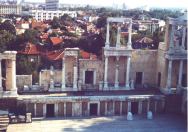 Today huge Roman walls from the times of Emperor August are extended for about 5 km, with over 20 mineral springs, a really lovely town. The modern people live near the ruins, and I had the sensation that they are unaware of them. I went alone to walk inside the ruins, and I found a painter. At first I thought he was just being inspired by the ruins, that he was painting a view of them. When I came closer, I realized that he was copying a small portrait of a woman, a clip of a magazine. He noticed me, and tried to speak with me. My ignorance of the Bulgarian language and his ignorance of the English language prevented the communication. I just kept walking, and thinking on the very idea of Roman people walking in the same paths.
Today huge Roman walls from the times of Emperor August are extended for about 5 km, with over 20 mineral springs, a really lovely town. The modern people live near the ruins, and I had the sensation that they are unaware of them. I went alone to walk inside the ruins, and I found a painter. At first I thought he was just being inspired by the ruins, that he was painting a view of them. When I came closer, I realized that he was copying a small portrait of a woman, a clip of a magazine. He noticed me, and tried to speak with me. My ignorance of the Bulgarian language and his ignorance of the English language prevented the communication. I just kept walking, and thinking on the very idea of Roman people walking in the same paths.  It did not take too long, and I was in Roman times, in a Roman bath or something. There was nobody there to deny it: just my clothes, and a vague sensation that I did not belong there. Back to reality, there are Thracian tombs well preserved in the surroundings. The Thracians lived in Bulgaria in the 7th century BC, and there is a lot of archaelogical things to see about that important people. One of the most outstanding places is Plovdiv (Пловдив), where they have an old amphitheatre that is still used today for some events. In Plovdiv they have a strong touristic-awareness: and so they charge to see the theatre, concerts and plays are held inside it, and in the city everything is “friendly”, to say it somehow. For example, we found a clay worker and he made some pottery in front of us, very interesting. He even had a business card, written in English. The city itself is an old and charming place, full of streets faced by old houses. But this “touristic-friendliness” did not charm my friends, who told me that is kind of artificial in Bulgaria, but it was a beautiful view in any case.
It did not take too long, and I was in Roman times, in a Roman bath or something. There was nobody there to deny it: just my clothes, and a vague sensation that I did not belong there. Back to reality, there are Thracian tombs well preserved in the surroundings. The Thracians lived in Bulgaria in the 7th century BC, and there is a lot of archaelogical things to see about that important people. One of the most outstanding places is Plovdiv (Пловдив), where they have an old amphitheatre that is still used today for some events. In Plovdiv they have a strong touristic-awareness: and so they charge to see the theatre, concerts and plays are held inside it, and in the city everything is “friendly”, to say it somehow. For example, we found a clay worker and he made some pottery in front of us, very interesting. He even had a business card, written in English. The city itself is an old and charming place, full of streets faced by old houses. But this “touristic-friendliness” did not charm my friends, who told me that is kind of artificial in Bulgaria, but it was a beautiful view in any case.
Small Towns
 Small country towns like Etar (Етъра) or Bozhentsi (Боженци) are closer to the real thing. They are as cute as a children’s tale. In Etar I bought a tambura, a kind of Bulgarian mandolin, and we had a very folkloric coffee (it was raining) in a pretty small house. Everything was made of wood. Not far from there we slept in Bozhentsi, in a cottage, and that was much better than any other European hotel. We were served by a very nice man -who played also the accordion- we ate excellently and had an even better breakfast, full of cheese and things that tasted strange for us, but undoubtely good. They use cheese and yoghurt in many different dishes, and that was one of the highlights of the trip: the excellent food. Especially something called guyveche (гювече), that is a dish prepared in a special (and individual) ceramic saucepan where it is finally served. It is delicious. I have bought a couple of those casseroles to cook the dish at home. One of the recipes is that guyvech prepared at the Rila Monastery. But back to Bozhentsi, we felt as if we were in a tidy small town that could belong to any age, and the people living there were as timeless as the houses. We have been in many towns in Bulgaria, and they are very of very different kinds: Sofia has that typical communist gray colour, Gabrovo (Габрово) seemed more colourful and even more modern, as Turnovo. Plovdiv and Varna, more prepared to attract tourists. We visit also a couple of cities of historical interest: Karlovo (Карлово), the natal place of Vassil Levski, the national Bulgarian hero who headed the revolution against the Turks, and Kalofer (Калофер), with the house of Christo Botev, a major poet and also hero from the revolution. Every city I have visited had nothing to do with those I was used in the “western world”, if you want. I mean, when I was in Rome or London, I noticed they had a unique and distinctive character, but somehow they were familiar, to say something. That was not the case here.
Small country towns like Etar (Етъра) or Bozhentsi (Боженци) are closer to the real thing. They are as cute as a children’s tale. In Etar I bought a tambura, a kind of Bulgarian mandolin, and we had a very folkloric coffee (it was raining) in a pretty small house. Everything was made of wood. Not far from there we slept in Bozhentsi, in a cottage, and that was much better than any other European hotel. We were served by a very nice man -who played also the accordion- we ate excellently and had an even better breakfast, full of cheese and things that tasted strange for us, but undoubtely good. They use cheese and yoghurt in many different dishes, and that was one of the highlights of the trip: the excellent food. Especially something called guyveche (гювече), that is a dish prepared in a special (and individual) ceramic saucepan where it is finally served. It is delicious. I have bought a couple of those casseroles to cook the dish at home. One of the recipes is that guyvech prepared at the Rila Monastery. But back to Bozhentsi, we felt as if we were in a tidy small town that could belong to any age, and the people living there were as timeless as the houses. We have been in many towns in Bulgaria, and they are very of very different kinds: Sofia has that typical communist gray colour, Gabrovo (Габрово) seemed more colourful and even more modern, as Turnovo. Plovdiv and Varna, more prepared to attract tourists. We visit also a couple of cities of historical interest: Karlovo (Карлово), the natal place of Vassil Levski, the national Bulgarian hero who headed the revolution against the Turks, and Kalofer (Калофер), with the house of Christo Botev, a major poet and also hero from the revolution. Every city I have visited had nothing to do with those I was used in the “western world”, if you want. I mean, when I was in Rome or London, I noticed they had a unique and distinctive character, but somehow they were familiar, to say something. That was not the case here.
The Seaside
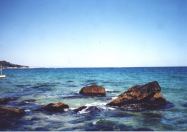 Perhaps the most “normal” city is Varna (Варна), where we met the beaches of the Black Sea. The seaside is beautiful, more beautiful than any beach in Argentina, naturally. The water is green and blue, but the sand is crowded. Probably this is the most touristic place in Bulgaria, and that tourism is business is something notorious. For the first time in our journey I heard people speaking in several languages, and local people knowing how to speak in English to please the tourists. The hotels are up there, and the prices too. There is seafood, and McDonalds. Totally different from the rest of the country. One thing that surprised me is that topless is something common there. While we hot Latins are supposed to be liberal about these things, we were amazed see all those naked bodies in the beach. We were prepared, somehow, by the fact that the regular Bulgarian girl is very uninhibited to dress, but this was a delicious surprise, I must admit. In any case, we swam in a place with rocks in the sea (and therefore less crowded), and we verified that the water was warm. Another perfect day. Near Varna there is another monastery, this time carved in the rock.
Perhaps the most “normal” city is Varna (Варна), where we met the beaches of the Black Sea. The seaside is beautiful, more beautiful than any beach in Argentina, naturally. The water is green and blue, but the sand is crowded. Probably this is the most touristic place in Bulgaria, and that tourism is business is something notorious. For the first time in our journey I heard people speaking in several languages, and local people knowing how to speak in English to please the tourists. The hotels are up there, and the prices too. There is seafood, and McDonalds. Totally different from the rest of the country. One thing that surprised me is that topless is something common there. While we hot Latins are supposed to be liberal about these things, we were amazed see all those naked bodies in the beach. We were prepared, somehow, by the fact that the regular Bulgarian girl is very uninhibited to dress, but this was a delicious surprise, I must admit. In any case, we swam in a place with rocks in the sea (and therefore less crowded), and we verified that the water was warm. Another perfect day. Near Varna there is another monastery, this time carved in the rock.  There is a big wall of rock almost in front of the sea, and the “monastery” is a horizontal hole drilled in the side of it, of about one meter deep. The monks lived there, and went down only to find some food. A really wild life, bereft of symbols to distract the life of the religious man. I stood there and thought that those monks should necessary be closer to God than their brothers in the regular churches. An ascetic life in the rock, you and the wind and the sea below, that must be something closer to a religious experience, even if you are not a monk. Now there are ladders and banisters there, but when the monks lived there nothing prevented them to fall, and to climb that high using just the hands, mmhh… By the way, the place is called Aladja (Аладжа манастир). Also not far from Varna is the Rider of Madara, a carved horseman in a tall cliff, about a hundred meters high, from 800 AD. We could not see much, because the inscriptions were surrounded by a special construction to keep the rocks from the erosion. And the beautiful journey ended in Varna, and we took the plane to Sofia again, to flight to Hungary. Bulgaria is one of the most beautiful countries I have ever seen, it is just a pity that is a bit closed for tourism. Or not: perhaps the best secrets are to be kept forever…
There is a big wall of rock almost in front of the sea, and the “monastery” is a horizontal hole drilled in the side of it, of about one meter deep. The monks lived there, and went down only to find some food. A really wild life, bereft of symbols to distract the life of the religious man. I stood there and thought that those monks should necessary be closer to God than their brothers in the regular churches. An ascetic life in the rock, you and the wind and the sea below, that must be something closer to a religious experience, even if you are not a monk. Now there are ladders and banisters there, but when the monks lived there nothing prevented them to fall, and to climb that high using just the hands, mmhh… By the way, the place is called Aladja (Аладжа манастир). Also not far from Varna is the Rider of Madara, a carved horseman in a tall cliff, about a hundred meters high, from 800 AD. We could not see much, because the inscriptions were surrounded by a special construction to keep the rocks from the erosion. And the beautiful journey ended in Varna, and we took the plane to Sofia again, to flight to Hungary. Bulgaria is one of the most beautiful countries I have ever seen, it is just a pity that is a bit closed for tourism. Or not: perhaps the best secrets are to be kept forever…
(If you’re interested, there’s a detailed map of the whole trip here)

